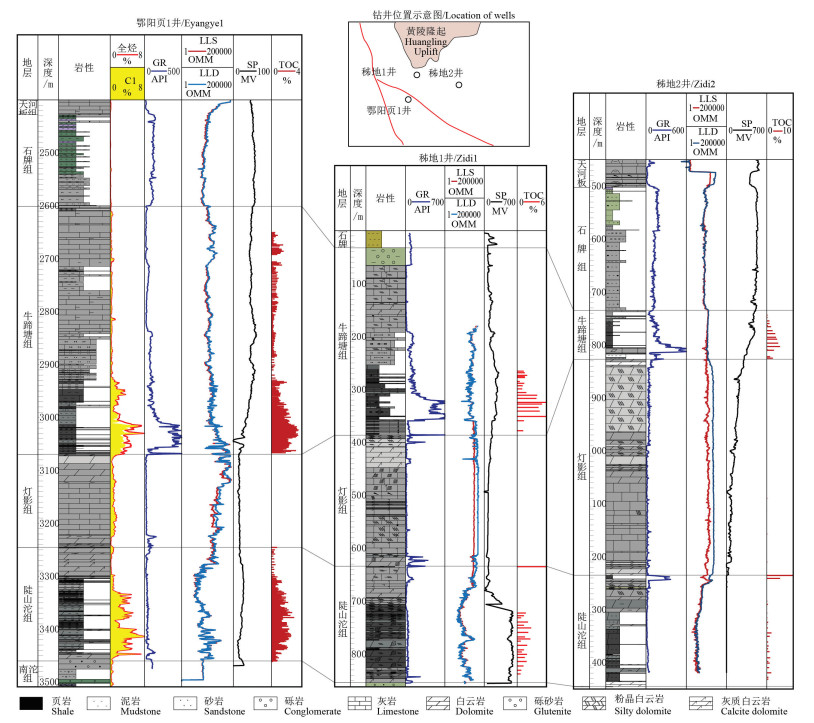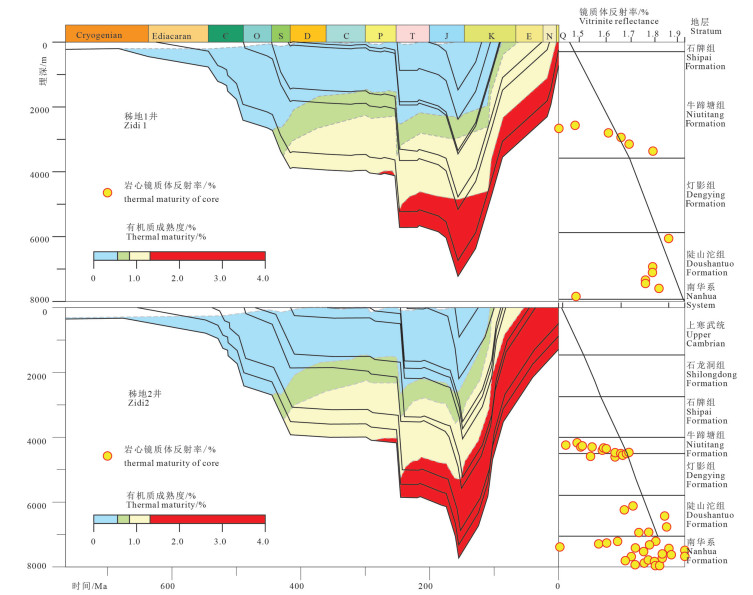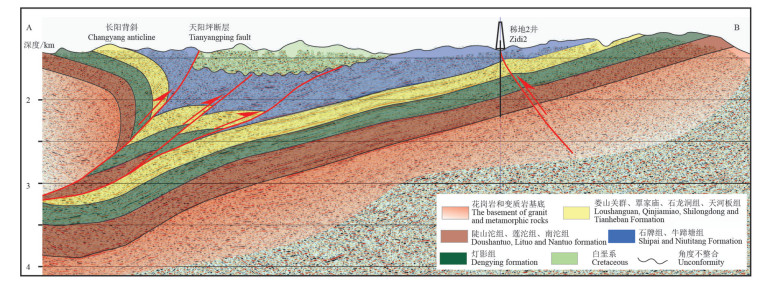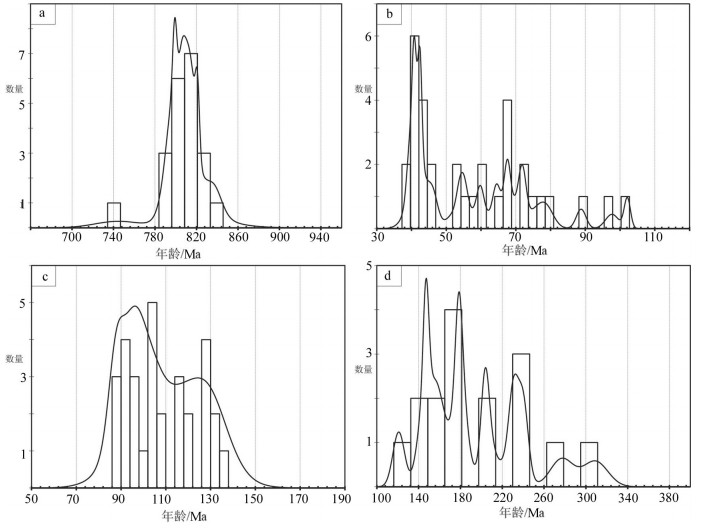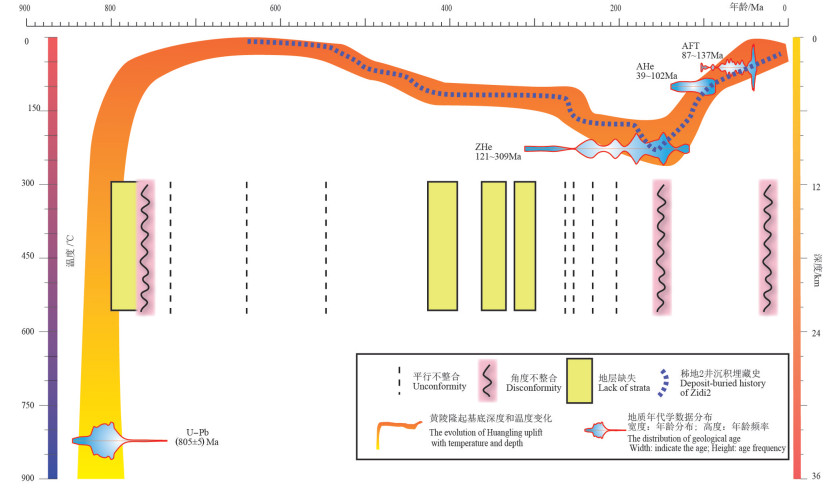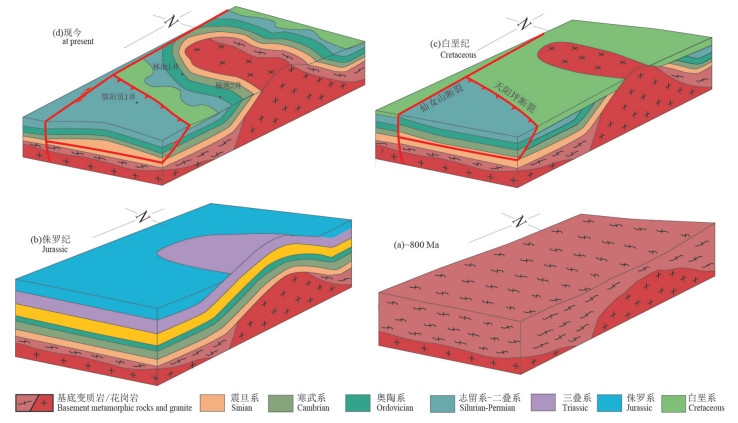Tectonic evolution of the Huangling uplift and its control effect on shale gas preservation in South China
-
摘要:
近期中国南方页岩气勘查在黄陵隆起南缘的下寒武统和震旦系取得重大突破,本文针对古老地层页岩气构造保存问题,研究黄陵隆起构造演化历史,反演钻井沉积地层埋藏史,通过二维地震剖面解析黄陵隆起南缘的构造学特征,统计分析相关地质年代学数据。认为该区域在约800 Ma经历了花岗岩侵入,形成了以花岗岩为主体的黄陵隆起基底;该区域在800~200 Ma构造较稳定,缺乏这一时期的构造年代学数据;中侏罗世震旦系陡山沱组埋深可达约8 km,晚侏罗世及以后经过多期抬升至现在的构造格局。本研究说明黄陵隆起的古老基底经过元古宙大量花岗岩侵入,可能均质性高而表现为刚性基底,后期所遭受构造改造程度较低,埋深相对较浅。因此,该地区页岩表现为演化程度适中,构造改造弱,后期热事件影响小,有利于页岩气的保存,是目前黄陵隆起南缘获得页岩气勘查突破的关键。并指出南方具有类似构造的雪峰山隆起、神农架背斜和汉南古陆周缘具有良好的下寒武统页岩气勘查潜力。
Abstract:Significant breakthrough of shale gas exploration has been made in Lower Cambrian and Sinian shale on the north margin of the Yangtze block, South China. In this paper, the authors focused on the preservation condition of shale gas, with the purpose of investigating the tectonic evolution history of the Huangling uplift by means of geological survey and 2D seismic, geochronological and drilling data. The results are as follows:at~800Ma, granite intrusion took place in the Huangling dome basement, primarily shown by granites replacing metamorphism rocks; during 800~200Ma, no significant tectonic movement occurred, with no geochorologic data; the Sinian shale was buried at the depth of about 8km during Middle Jurassic. This study indicates that the rigid basement of the Huangling uplift was mainly composed of homogeneous granite, without intensive deformation. As the main challenges of the widely distributed Lower Cambrians and Sinian shale are high-maturity and intensive deformation, a geological unit with a dome probably is a favorable zone for the old age shale gas. Therefore, it is shown that the adjacent zones of the the Xuefengshan, Shennongjia and Hannan are geological units with a dome and probably have potentials for the exploration of shale in the Lower Cambrian strata.
-
1. 引言
中国中国南方页岩气勘探主要目的层系为上奥陶—下志留统五峰—龙马溪组、下寒武统牛蹄塘组(筇竹寺组)和震旦系陡山沱组(梁狄刚等,2008;李玉喜等,2009;张金川等,2009;董大忠,2011;张大伟等,2011;EIA,2013;Hao et al., 2013;翟刚毅等,2017;Zhai et al., 2018a, 2018b),目的层为五峰—龙马溪组的页岩气田已经在重庆焦石坝、长宁—威远地区取得了突破(郭彤楼等,2014;郭旭升,2014;王志刚,2015)。但是中国南方下寒武统、震旦系等古老地层页岩成熟度普遍偏高或保存条件差,很多针对这两套层系的页岩气钻井显示不含气或氮气含量高(邹才能等,2016),前期仅在威远(董大忠等,2012)与黔北岑巩地区取得一定的发现(冷济高等,2016)。2013年以来,中国地质调查局在黄陵隆起南翼部署实施秭地1井和秭地2井两口页岩气调查井,获得了下寒武统牛蹄塘组和震旦系陡山沱组的页岩气重大发现(图 1),并在后期部署实施的鄂阳页1井在宜昌地区寒武系和震旦系获重大突破(图 1;李浩涵等,2017;Bao et al., 2018)。
![]() 图 1 黄陵隆起大地构造位置图(a,修改自Ji et al., 2014)、黄陵隆起南翼地质简图(b)及黄陵隆起南翼构造地质剖面(c,基于二维地震剖面)Figure 1. Tectonic map of the South China block and the location of the Huangling uplift (a, modified from Ji et al., 2014); geological map of the southern limb of the Huangling uplift (b) and structural section on the southern limb of the Huangling uplift (c, after seismic profile)
图 1 黄陵隆起大地构造位置图(a,修改自Ji et al., 2014)、黄陵隆起南翼地质简图(b)及黄陵隆起南翼构造地质剖面(c,基于二维地震剖面)Figure 1. Tectonic map of the South China block and the location of the Huangling uplift (a, modified from Ji et al., 2014); geological map of the southern limb of the Huangling uplift (b) and structural section on the southern limb of the Huangling uplift (c, after seismic profile)本文以勘查程度较高的黄陵隆起南缘页岩气地质条件为研究对象,利用野外地质调查、二维地震资料和钻井成果,全面分析了钻井沉积埋藏史、二维地震特征和地质年代学数据,解剖该地区的构造演化历史,分析了黄陵隆起南缘页岩气构造保存条件和控制作用。
2. 地质背景
黄陵隆起位于中扬子北部地区,其核部主体是由新太古代—古元古代的崆岭群高级变质的片麻岩岩系构成,并被新元古代黄陵花岗岩大面积侵入(马大栓等, 1997, 2002)。南华系莲沱组作为沉积盖层不整合覆盖于其上(图 1b)。震旦纪—侏罗纪盖层由老到新呈环状分布,构成穹隆形态(张或丹,1986;江麟生等,2002;李益龙等,2007;Ji et al., 2014)。
黄陵隆起周缘的沉积盖层自核部由老到新从震旦系至中生界均有分布,其南翼主要发育震旦纪至奥陶纪沉积岩,白垩系不整合覆盖于古生代地层之上(图 1b)。研究区南翼沉积盖层主要倾向南,发育两条主要断层:天阳坪断裂和仙女山断裂(图 1b),前者为向北东方向逆冲的断层,后者为走滑断层。该区主要发育震旦系陡山沱组和下寒武统牛蹄塘组两套富有机质页岩(湖北省地质调查院,2011),两套页岩分布面积广、厚度大、有机碳含量高。2008年,三峡大坝的翻坝高速在建设过程中季家坡隧道陡山沱组地层施工时点火燃烧,说明了陡山沱组具有页岩气勘查的潜力(图 1b)。中国地质调查局自2013年开始,部署实施地质调查井工程秭地1井和秭地2井(全井段取心),秭地1井和秭地2井井深分别为862 m和1446 m,牛蹄塘组页岩厚度分别为104 m和63.3 m,其中有机质含量(TOC)大于1%层段厚度分别为97 m和41.5 m;陡山沱组黑色页岩厚度分别为142.6 m和141 m,TOC大于1%层段厚度分别为108 m和41.6 m。两口调查井都进行了页岩的现场含气性解析,两套层系的含气量均大于1 m3/t,获得了震旦系陡山沱组和下寒武统牛蹄塘组两套含气页岩层系的重要发现(图 2)。同时,还在该区部署了二维地震工程195 km,形成了二维地震测网(图 1),查明了研究区构造几何学特征。依据调查井和二维地震结果,部署实施鄂阳页1井参数井,该钻井位于宜昌长阳贺家坪镇(图 1b),完钻井深3509 m,在震旦系南沱组冰积砾岩完钻,钻获牛蹄塘组和陡山沱组两套目的层(图 2),该井牛蹄塘组黑色页岩厚度141 m,现场含气量最高可达4.48 m3/t;陡山沱组黑色页岩厚度115.7 m,含气量最高达4.8 m3/t。在陡山沱组进行了直井压裂试气,获得5460 m3/d页岩气直井产量,获得了中扬子地区页岩气重大突破(翟刚毅等,2017;陈科等,2017)。这些项目获得了大量的地质和油气相关数据,有必要对这些数据和成果进行整理,提高对古老层系页岩气勘查和油气保存条件的认识。
3. 构造演化数据
3.1 生烃史分析
本研究选择研究区两口获取全井岩心的调查井秭地1井和秭地2井,应用德国IES公司的PetroMod盆地模拟软件进行沉积埋藏史及生烃演化史重建。根据区域资料(刘海军等,2009;郭云飞,2010;肖朝晖,2010)及钻井数据,对地质年龄、地层分层数据、地层接触关系、岩性、岩石孔隙度-压实曲线、古大地热流值、海拔高程、古水深等参数进行赋值(表 1),并结合前人对邻区地层剥蚀量的研究成果(卢庆治等,2007;刘海军等,2009;李天义等,2012)。古大地热流自早古生代以来经历了低—高—低的变化趋势(徐二社等,2015)。卢庆治等(2007)对鄂西—渝东地区的热史恢复结果表明,研究区自早古生代初期到晚二叠世古热流持续增大,呈现为一个持续增温的过程,由50 mW/m2增加到68 mW/m2;从晚二叠世初到现今古热流持续降低为42 mW/m2。李天义等(2012)的模拟结果表明,邻近的当阳地区从晚三叠世到现今大地热流变化范围为63~43 mW/m2。刘进(2008)研究认为研究区的现今大地热流值介于46~42 mW/m2。本研究两口井的热流值分别取42 mW/m2和46 mW/m2(表 1),代表了本区的热流值特征。
Table 1. Key parameters of burial-hydrocarbon generation history simulation of well Zidi1 and Zidi 2 (after Lu Qingzhi et al., 2007; Liu Jin et al., 2008)
本研究区及周缘中扬子区研究表明印支期、燕山期及喜山期构造剥蚀量较大。卢庆治等(2007)根据古热流反演拟合法推算,邻近的建始地区建28井中生界与新生界之间的不整和面剥蚀厚度为2800 m,其他各不整合面剥蚀厚度均在300 m左右。郭云飞(2010)求取了中扬子7口典型单井的剥蚀厚度,结果表明燕山期剥蚀厚度最大为4145.2 m。李天义等(2012)利用锆石及磷灰石裂变径迹、镜质体反射率资料,计算出邻近的当阳地区在燕山期和喜山期经历了两次大规模埋深加热过程和两次重要构造抬升-剥蚀冷却事件,其最大剥蚀厚度分别约为4800 m和2400 m。本研究基于古温标镜质体反射率法,结合前人成果认识对研究区秭地1井和秭地2井剥蚀量进行计算,结果表明加里东期剥蚀厚度较小,在进行埋藏史重建时可以忽略不计,海西期几乎没有发生剥蚀,印支期存在轻微剥蚀,燕山期和喜山期剥蚀厚度较大,累计为5300~5600 m(表 1)。利用盆地模拟软件,古地表温度取平均温度22.5℃,古水深取值0~225 m,依据Easy Ro模型,恢复了两口井的埋藏史和生烃演化史(图 3)。
两口井的埋藏史恢复结果表明,研究区埋藏特征为早期持续沉降—中期抬升—晚期深剥,这与西部鄂西建始地区石油钻井热模拟结果一致(肖朝晖,2010)。研究区在加里东期以前处于稳定的持续沉降、埋藏过程。印支期,本区构造变形不明显,主要表现为差异升降,秭归盆地开始形成。早侏罗世—中侏罗世为研究区快速沉降阶段,早燕山末强烈抬升之前,最大埋深达到约7800 m。燕山期—喜山期,此后进入了全面抬升阶段,下古生界大面积出露。
根据前人热史模拟结果(卢庆治等2007;肖朝晖,2010),湘鄂西地区震旦纪—早奥陶世古地温梯度变化不大,震旦纪(Z)为2.2℃/100m左右,寒武纪(Є)为2.3℃/100m左右,奥陶纪(O)为2.4℃/100m左右。中奥陶世华南地区构造运动加剧,使得志留系地温梯度略有升高为2.6℃/100m左右,志留纪末期受广西运动的影响,石炭纪(C)略高为2.7℃/100m左右,二叠纪(P)为3.0℃/100m左右,三叠纪—白垩纪(T—K)为2.4℃/100m左右。喜山期南部热沉降,地温梯度降低,第四纪(Q)为1.8℃/100m左右。根据这些参数,秭地1井生烃史模拟结果表明,牛蹄塘组页岩在中志留世就已经进入生油阶段,并逐步达到生油高峰,到二叠纪末期进入热裂解生凝析油气阶段,至三叠纪中期热演化定型并直到现今(图 3),现今牛蹄塘组页岩Ro为1.43%~1.79%,处于高成熟热演化阶段。秭地2井牛蹄塘组页岩的生烃演化过程略早于秭地1井,于早志留世末期进入生油阶段,并逐步达到生油高峰,到二叠纪末期进入热裂解生凝析油气阶段,晚海西—印支旋回的快速埋藏过程使有机质热演化程度迅速增加,至中三叠世晚期达到热裂解生干气阶段,于侏罗纪末期热演化定型,现今牛蹄塘组页岩Ro为1.97%~2.59%,处于过成熟热演化阶段。
3.2 二维地震构造解释剖面
研究区开展了详细的二维地震采集与处理解释工作,形成间距大约为5 km的二维地震测网(图 1b),本文优选经过天阳坪断裂的二维地震剖面1条(位置见图 1b),剖面走向为北北西-南南东向,北侧为沉积盖层与基底的接触带,南部穿过天阳坪断层,到达长阳背斜的东北缘,页岩气调查井秭地2井位于剖面的北部斜坡位置。剖面显示天阳坪断层是一条叠瓦式推覆断层,在深部产状平缓,向上分支至地表(图 4),断层向北东方向的推覆距离可能超过5 km,相对来说,断裂上盘已经受到强烈的变形改造,且通过断裂可以与地表沟通,此外白垩系位于天阳坪断层下盘,说明天阳坪活动的时间在白垩纪晚期及以后,断裂下盘的地层构造改造强度并不大,仍然属于稳定的原地系统,调查井秭地2井的高含气结果说明逆冲断裂下盘具有较好的页岩气保存条件。
3.3 年代学数据
黄陵隆起是华南地质学研究的热点,早期对其年代学研究也具有大量的数据公开发表,本研究收集了不同方法的年代学数据,包括U-Pb、Rb-Sr和Ar-Ar等方法。黄陵花岗岩锆石U-Pb年龄为794~837 Ma,峰值为810 Ma,代表其侵位时代(图 5a;马国干等,1984;冯定犹等,1991;李志昌等,2002;Li et al., 2004;凌文黎等,2006;Zhang et al., 2008, 2009;高维和张传恒,2009)。闪长岩-英云闪长岩杂岩的矿物Rb-Sr等时线年龄为(805±5)Ma,可能是代表岩体的初始冷却年龄(冯定犹等,1991)。角闪石和黑云母的40Ar/39Ar年龄分布于770~900 Ma(胡世玲等,1989;李志昌等,2002)。为了限定黄陵隆起抬升的时间,前人已进行了详细的低温年代学工作(Hu et al., 2006;沈传波等,2009;Richardson et al., 2010;Xu et al., 2010;Li and Shan, 2011;Hu et al., 2012;Ji et al., 2014)。磷灰石裂变径迹年龄分布从87~137 Ma,峰值为120 Ma(图 5c);3组锆石裂变径迹年龄从分布在(158±50)Ma、(178±34)Ma、(195±14)Ma,误差范围比较大;磷灰石He测定年龄从39 Ma至102 Ma,主要集中在40~45 Ma;ZHe年龄比较分散,为121~309 Ma。此外,刘海军等(2009)报道了采样于黄陵隆起东翼寒武系、志留系、侏罗系和白垩系碎屑岩的9个磷灰石裂变径迹年龄,认为黄陵隆起形成于100~165 Ma。
4. 讨论
4.1 黄陵隆起构造演化史
本研究将3种不同方法得出的构造演化数据进行综合分析,(1)秭地1井和秭地2井钻井沉积埋藏史,由于两口钻井分析结构相似,优选深度达到1500 m的秭地2井结果;(2)通过野外地质调查和二维地震数据得出的主要不整合和断层接触关系;(3)多种方法测试的地质年代学数据统计。由于沉积埋藏史分析对应深度,而地质年代学数据对应温度,本文利用2.5℃/100m的线性关系表示深度与时间(卢庆治等,2005),并将主要的构造事件标注在同一个坐标体系,结果显示地质年代学数据、秭地2井沉积埋藏史数据和主要的构造事件能够很好吻合(图 6)。锆石U-Pb年龄所展现的约800 Ma为岩浆侵入的年龄,黄陵隆起核部大部分出露为花岗岩(湖北省地质调查院,2011),指示岩体在深部的分布面积更大,而重磁数据指示黄陵隆起的三斗坪岩体之下存在范围较大低密度区(张毅等,2012),说明新元古代震旦纪早期黄陵隆起变质岩基底可能被改造成以花岗岩为主,具有很强的均质性。黄陵隆起被花岗岩侵入之后,基底以上地层接受较为连续的沉积。
黄陵隆起缺失800~200 Ma测年数据(图 6),但是泥盆纪—石炭纪地层缺失,结合整个湘鄂西地区泥盆系和石炭系均缺失或非常薄,说明为区域抬升或是海平面升降引起,黄陵隆起构造改造活动并不强烈。锆石的He测定年龄分布在约200 Ma,该方法对应的温度约为180℃,深度约为7.2 km,而沉积埋藏史分析结果显示这一时期,沉积地层被埋深到最深的位置,在中侏罗世埋深最深,最高可达约7.8 km,但是这一时期的年代学结果分布范围大,从121~309 Ma均有分布,这可能与测试的精确度、取样岩性和构造部位的不同有关(沈传波等,2009)。
磷灰石裂变径迹测试得出的时间范围是87~137 Ma,对应的埋深为120℃,深度约为4.8 km,年龄集中在120 Ma,而秭地2井的沉积埋藏史分析与该时期年代学数据高度吻合(图 6)。说明白垩纪发生快速抬升事件,且在约120 Ma抬升速率发生变化。
磷灰石He测定年龄从39 Ma至102 Ma,主要集中在40~45 Ma,这一集中的时间段与秭地2井沉积埋藏史高度吻合(图 6)。而结合二维地震资料(图 4),这一抬升构造过程伴随着天阳坪断层的北东向逆冲推覆,仙女山走滑断层活动至新近纪(张峰等,1998)。
4.2 对页岩气的保存作用
黄陵隆起的关键构造演化历史分为4个阶段,分别是:(1)黄陵隆起变质岩基底在约800 Ma被花岗岩侵入,形成以花岗岩为主的刚性基底(图 7a);(2)侏罗纪中期黄陵隆起及周边地区被埋藏至最深,晚侏罗世开始隆起,影响黄陵隆起东西两侧的分布(图 7b);(3)晚白垩世天阳坪断层开始活动,古生代地层被逆冲推覆到白垩纪地层之上,此后仙女山断裂开始走滑并错断天阳坪断层(图 7c);(4)白垩系大面积被剥蚀,仙女山断裂继续活动至新近纪(张峰等,1998),形成目前的构造格局(图 7d)。
![]() 图 7 黄陵隆起隆升模式图a—三叠纪时期黄陵隆起及周缘连续沉积;b—晚侏罗世黄陵隆起开始抬升;c—白垩纪晚期天阳坪断裂和仙女山断裂开始形成;d—形成目前的构造形态,黄陵隆起南翼页岩气保存条件较好,获得下寒武统和震旦系页岩气重大突破Figure 7. The evolution model of the Huangling uplifta-Sequential deposition during Triassic in the Huangling area; b-Initial uplifting in Jurassic; c-Tianyangping fault and Xiannvshan fault formed during Cretaceous; d-Present structure, where the southern limb has well preservation condition of shale gas, with breakthrough in exploration of Cambrian and Sinian shale gas
图 7 黄陵隆起隆升模式图a—三叠纪时期黄陵隆起及周缘连续沉积;b—晚侏罗世黄陵隆起开始抬升;c—白垩纪晚期天阳坪断裂和仙女山断裂开始形成;d—形成目前的构造形态,黄陵隆起南翼页岩气保存条件较好,获得下寒武统和震旦系页岩气重大突破Figure 7. The evolution model of the Huangling uplifta-Sequential deposition during Triassic in the Huangling area; b-Initial uplifting in Jurassic; c-Tianyangping fault and Xiannvshan fault formed during Cretaceous; d-Present structure, where the southern limb has well preservation condition of shale gas, with breakthrough in exploration of Cambrian and Sinian shale gas近期,黄陵隆起及其周缘震旦系、寒武系获得页岩气重大发现,黄陵隆起周缘的秭地1井、鄂阳页1井等下寒武统牛蹄塘组页岩岩心较为完整,表明了黄陵隆起刚性基底对区域整体构造有一定抗变形作用;而黄陵隆起抬升时间较晚,在一定程度上保证了早期沉积的震旦系、寒武系在漫长的地质时期未遭受严重破坏,而燕山期以后的构造运动仅仅在浅层形成若干个推覆构造,并未对断裂下盘的震旦系、寒武系页岩气的保存产生实质的破坏。
黄陵隆起周缘尤其是断裂下盘地区具有良好的页岩气保存条件,富有机质页岩成熟度适中、地层构造较为简单,这为中国南方地区古老地层页岩气勘探打开了一扇窗。页岩气的保存可从空间和时间两个方面考虑,空间上有垂向和横向两个控制因素,垂向上即顶底板条件,而横向上油气运移是垂向上运移的2~8倍(据中石化勘探分公司),所以页岩与开放边界的距离是横向运移的主控因素,开放边界主要为张性断裂和出露地表的露头;而时间方面的保存条件主要考虑页岩是否埋深过大,导致成熟度过高,还要考虑富有机质页岩在演化历史中是否有液态烃或者气态烃在空间上的扩散。其难点是恢复页岩所在地质体的沉积构造历史,根本问题还是基础沉积和构造地质问题。
湘鄂西雪峰山隆起周缘、神农架背斜周缘、汉南古陆周缘均大面积分布厚度大、有机质含量高的下寒武统牛蹄塘组页岩(梁狄刚等,2008),在构造上均有类似的隆起构造,具有成熟度适中,构造改造弱的相似特征,是下一步中国南方古老层系页岩气勘查的主要方向。
5. 结论
黄陵隆起所在扬子基底变质岩被新元古代花岗岩大面积置换,新元古界沉积岩(莲沱组至灯影组)不整合覆盖在古老基地之上,接受较连续沉积,海西期和印支期构造抬升较弱,期间的不整合面为区域性沉降所致,中侏罗世埋藏至最深,晚侏罗世开始隆升,黄陵隆起核部抬升幅度最大,剥蚀至新元古代花岗岩,局部还残留变质岩基底,形成目前的构造格局。
黄陵隆起南缘页岩气保存条件较好,一是基底主要由力学性质较均一的元古宙花岗岩组成,在沉积构造演化的过程中作为一个较完整的构造单元,受到断裂和褶皱的改造较小;二是在页岩层系沉降埋藏过程中陡山沱组埋藏的深度最深7800 m,热演化程度有利于有机质生烃并富集于页岩之中。
中国南方地区古老层系,如下寒武统牛蹄塘组、震旦系陡山沱组,富有机质页岩分布广厚度大,适中的成熟度和良好的构造保存条件是页岩气富集的关键。华南复杂构造区雪峰山隆起、神农架背斜、汉南古陆具有类似黄陵隆起的古隆起构造特征,其周缘地区为古老层系页岩气勘探的有利地区,建议开展基础沉积地质和构造地质研究,并进行重点勘查。
-
图 1 黄陵隆起大地构造位置图(a,修改自Ji et al., 2014)、黄陵隆起南翼地质简图(b)及黄陵隆起南翼构造地质剖面(c,基于二维地震剖面)
Figure 1. Tectonic map of the South China block and the location of the Huangling uplift (a, modified from Ji et al., 2014); geological map of the southern limb of the Huangling uplift (b) and structural section on the southern limb of the Huangling uplift (c, after seismic profile)
图 7 黄陵隆起隆升模式图
a—三叠纪时期黄陵隆起及周缘连续沉积;b—晚侏罗世黄陵隆起开始抬升;c—白垩纪晚期天阳坪断裂和仙女山断裂开始形成;d—形成目前的构造形态,黄陵隆起南翼页岩气保存条件较好,获得下寒武统和震旦系页岩气重大突破
Figure 7. The evolution model of the Huangling uplift
a-Sequential deposition during Triassic in the Huangling area; b-Initial uplifting in Jurassic; c-Tianyangping fault and Xiannvshan fault formed during Cretaceous; d-Present structure, where the southern limb has well preservation condition of shale gas, with breakthrough in exploration of Cambrian and Sinian shale gas
表 1 秭地1井和秭地2井埋藏-生烃史模拟关键参数(部分数据卢庆治等,2007;刘进,2008)
Table 1 Key parameters of burial-hydrocarbon generation history simulation of well Zidi1 and Zidi 2 (after Lu Qingzhi et al., 2007; Liu Jin et al., 2008)

-
Bao Shujing, Zhai Gangyi, Zhou Zhi, Yu Shufang, Chen Ke, Wang Yufang, Wang Hao, Liu Yimin. 2018. The evolution of the Huangling uplift and its control on the accumulation and preservation of shale gas[J]. China Geology, 1:346-353. doi: 10.31035/cg2018052.
Dong Dazhong, Zou Caineng, Li Jianzhong, Wang Shejiao, Li Xinjing, Wang Yuman, Li Denghua, Huang Jinliang. 2011. Resource potential, exploration and development prospect of shale gas in the whole world[J]. Geological Bulletin of China, 30(2/3):324-336(in Chinese with English abstract). http://www.wanfangdata.com.cn/details/detail.do?_type=perio&id=zgqydz201102018
Dong Dazhong, Zou Caineng, Li Jianzhong, Wang Shejiao, Li Xinjing, Wang Yuman, Chen Gensheng, Wang Shiqian, Lü Zhonggang, Huang Yongbin, 2012. Progress and prospects of shale gas exploration and development in China[J]. Acta Petrolel Sinica, 33(S1): 107-114(in Chinese with English abstract). http://en.cnki.com.cn/Article_en/CJFDTOTAL-SYXB2012S1015.htm
EIA. 2013. Technically Recoverable Shale Oil and Shale Gas Resources: An Assessment of 137 Shale Formations in 41Countries outside the United States[R]. Energy Information Administration Report: 20.
Feng Dingyou, Lin Zhichang, Zhang Zhichao. 1991. Intrusive ages and isotopic characteristics of massives in the south of Huangling granitoids[J]. Hubei Geology, 5(2):1-12(in Chinese).
Gao Wei, Zhang Chuanheng. 2009. Zircon SHRIMP U-Pb ages of the Huangling granite and the tuff beds from Liantuo Formation in the Three Gorges area of Yangtze River, China and its geological significance[J]. Geological Bulletin of China, 28(1):45-50(in Chinese with English abstract). http://cn.bing.com/academic/profile?id=eb426598023f1b70062914c16302dfe1&encoded=0&v=paper_preview&mkt=zh-cn
Guo Tonglou, Zhang Hanrong. 2014. Formation and enrichment model of Jiaoshiba shale gas field, Sichuan Basin[J]. Petroleum Exploration and Development, 41(1):28-36(in Chinese with English abstract). http://en.cnki.com.cn/Article_en/CJFDTOTAL-SKYK201401003.htm
Guo Xusheng, Hu Dongfeng, Wen Zhidong, Liu Ruobin. 2014. Major factors controlling the accumulation and high productivity in marine shale gas in the Lower Paleozoic of Sichuan Basin and its periphery:A case study of the Wufeng-Longmaxi Formation of Jiaoshiba area[J]. Geology in China, 41(3):893-901(in Chinese with English abstract). http://en.cnki.com.cn/Article_en/CJFDTotal-DIZI201403016.htm
Guo Yunfei. 2010. The Efficient Hydrocarbon Supply of the Highover Mature Source Rock in the Wester of the Middle Yangtze Region: Taking the Cambrian as an Example[D]. Xi'an: Xi'an Shiyou University(in Chinese with English abstract).
Hao Fang, Zou Huayao, Lu Yongchao. 2013. Mechanisms of shale gas storage:Implications for shale gas exploration in China[J]. AAPG Bull., 97(8):1325-1346. doi: 10.1306/02141312091
Hu Jianmin, Chen Hong, Qu Hongjie, Wu Guoli, Yang Jiaxi, Zhang Zhongyi. 2012. Mesozoic deformations of the Dabashan in the southern Qinling orogen, central China[J]. J. Asian Earth Sci., 47, 171-184. doi: 10.1016/j.jseaes.2011.12.015
Hu Shengbiao, Raza A, Min K, Kohn B P, Reiners P W, Ketcham R A, Wang Jiyang, Gleadow A J W. 2006. Late Mesozoic and Cenozoic thermotectonic evolution along a transect from the north China craton through the Qinling orogen into the Yangtze craton, central China[J]. Tectonics, 25(6):TC6009. http://dx.doi.org/10.1029/2006TC001985.
Hu Shiling, Liu Hongyun, Wang Songshan, Hu Wenhu, Sang Haiqing, Qiu Ji. 1989. On the age of Sinian Lower Boundary infered from the new Ar/Ar data[J]. Scientia Geologica Sinica, (1):16-25(in Chinese). http://www.wanfangdata.com.cn/details/detail.do?_type=perio&id=QK000000368775
Ji Wenbin, Lin Wei, Faure M, Chu Yang, Wu Lin, Wang Fei, Wang Jun, Wang Qingchen. 2014. Origin and tectonic significance of the Huangling massif within the Yangtze craton, South China[J]. J.Asian Earth Sci, 86:59-75. doi: 10.1016/j.jseaes.2013.06.007
Jiang Linsheng, Chen Tielong, Zhou Zhongyou. 2002. Several principal geological problems in Hualing[J]. Hubei Geology & Mineral Resources, 16(1):8-13(in Chinese with English abstract). http://www.wanfangdata.com.cn/details/detail.do?_type=perio&id=hbdk200201003
Leng Jigao, Gong Dajian, Li Fei, Li Peng. 2016. Analyses on the shale gas exploration prospect of the Niutitang Formation in northeastern Guizhou area[J]. Earth Science Frontiers, 23(2):29-38(in Chinese with English abstract). http://d.old.wanfangdata.com.cn/Periodical/dxqy201602004
Li Haohan, Song Teng, Chen Ke, Lin Tuo, Jin Chunshuang, Meng Fanyang, Wang Peng, Zhang Yanlin, 2017. The discovery of shale gas from Sinian Formation at ZD-2 well in western Hubei[J]. Geology in China, 44(4):812-813(in Chinese with English abstract). http://www.wanfangdata.com.cn/details/detail.do?_type=perio&id=zgdizhi201704014
Li Tianyi, He Sheng, He Zhiliang, Wo Yujin, Zhou Yan, Wang Furong, Yang Xingye. 2012. Reconstruction of tectonic uplift and thermal history since Mesozoic in the Dangyang synclinorium of the central Yangtze area[J]. Acta Petrolei Sinica, 33(2):213-224(in Chinese with English abstract). http://www.wanfangdata.com.cn/details/detail.do?_type=perio&id=syxb201202005
Li Xiaoming, Shan Yehua. 2011. Diverse exhumation of the Mesozoic tectonic belt within the Yangtze Plate, China, determined by apatite fission-track thermochronology[J]. Geosciences Journal, 15(4):349-357. doi: 10.1007/s12303-011-0037-5
Li Yilong, Zhou Hanwen, Li Xianhua, Luo Qinghua. 2007.40Ar-39Ar plateau ages of biotite and amphibole from tonalite of Huangling granitoids and their cooling curve[J]. Acta Petrologica Sinica, 23(5):1067-1074(in Chinese with English abstract). http://www.wanfangdata.com.cn/details/detail.do?_type=perio&id=ysxb98200705019
Li Yuxi, Nie Haikuan, Long Pengyu. 2009. Development characteristics of organic rich shale and strategic selection of shale gas exploration area in China[J]. Natural Gas Industry, 29(12):115-118(in Chinese with English abstract). http://www.wanfangdata.com.cn/details/detail.do?_type=perio&id=trqgy200912034
Li Zhenxiang X, Evans D A D, Zhang Shihong. 2004. A 90° spin on Rodinia:Possible causal links between the Neoproterozoic supercontinent, superplume, true polar wander and low-latitude glaciations[J]. Earth Planet Sclett, 220(3/4):409-421.
Li Zhenxiang, Li Xianhua. 2007. Formation of the 1300-km-wide intracontinental orogen and postorogenic magmatic province in Mesozoic South China:A flat-slab subduction model[J]. Geology, 35(2):179-182. doi: 10.1130/G23193A.1
Li Zhichang, Wang Guihua, Zhang Zichao. 2002. Isotopic age spectrum of the Huangling granitic batholith, wetern Hubei[J]. Geology and Meneral Resources of South China, (3):19-28(in Chinese with English abstract). http://en.cnki.com.cn/Article_en/CJFDTOTAL-HNKC200203003.htm
Liang Digang, Guo Tonglou, Chen Jianping, Bian Lizeng, Zhao Zhe. 2008. Distribution of four suits of regional marine source rocks[J]. Marine Origin Petroleum Geology, 13(2):1-16(in Chinese with English abstract). http://www.wanfangdata.com.cn/details/detail.do?_type=perio&id=hxyqdz200802001
Ling Wenli, Gao Shan, Cheng Jianpin, Jian Linsheng, Yuan Honglin, Hu Zhaochu. 2006. Neoproterozoic magmatic events within the Yangtze continental interior and along its northern margin and their tectonic implication:Constraint from the ELA-ICPMS U-Pb geochronology of zircons from the Huangling and Hannan complexes[J]. Acta Petrologica Sinica, 22(2):387-396(in Chinese with English abstract). http://en.cnki.com.cn/Article_en/CJFDTOTAL-YSXB200602011.htm
Liu Haijun, Xu Changhai, Zhou Zuyi, Donelick R A. 2009. The AFT geochronology data constrain of the Huangling uplift(165-100Ma)[J]. Progress in Natural Science, 19(12):1326-1332(in Chinese).
Liu Jin. 2008. Geothermal Field Evolution and Organic Maturity of Mesozoic and Paleozoic in Western Hubei-Eastern Chongqing Area[D]. Wuhan: China University of Geoscience(in Chinese with English abstract).
Lu Qingzhi, Hu Shenbiao, Guo Tonglou, Li Zhongping. 2005. The background of the geothermal field for formation of abnormal high pressure in the northeastern Sichuan basin[J]. Chinese J. Geophys., 48(5):1110-1116(in Chinese). http://d.old.wanfangdata.com.cn/Periodical/dqwlxb200505019
Lu Qingzhi, Ma Yongsheng, Guo Tonglou, Hu Shengbiao. 2007.Thermal history and hydrocarbon generation history in western Hubei-Eastern Chongqing area[J]. Chinese Journal of Geology, 42(1):189-198(in Chinese with English abstract). http://www.wanfangdata.com.cn/details/detail.do?_type=perio&id=dzkx200701016
Ma Daquan, Du Shaohua, Xiao Zhifa. 2002. The origin of Huangling granite batholith[J]. Acta Petrologica et Mineralogica, 21(2):151-161(in Chinese). http://www.wanfangdata.com.cn/details/detail.do?_type=perio&id=yskwxzz200202009
Ma Daquan, Li Zhichang, Xiao Zhifa. 1997. The constitue, Geochronology and Geologic evolution of the Kongling complex, Western Hubei[J]. Acta Geoscientia Sinica, 18(3):233-241(in Chinese).
Ma Guogan, Li Huaqin, Zhang Zhichao. 1984. The research of the Sinian time limit range[J]. Yichang Institute of Geology and Mineral Resources, Chinese Academy of Geological Sciences, the No8(in Chinese).
Richardson N J, Densmore A L, Seward D, Wipf M, Li Yong. 2010.Did incision of the three gorges begin in the Eocene?[J] Geology, 38(6):551-54. doi: 10.1130/G30527.1
Shen Chuanbo, Mei Lianfu, Liu Zhaoqian, Xu Sihuang. 2009. Apatite and zircon fission track data, evidences for the MeosozicCenozoic uplift of Huangling Dome, Central China[J]. J. Mineral Petrol. 29(2):54-60(in Chinese with English abstract).
Wang Zhigang. 2015. Breakthrough of Fuling shale gas exploration and development and its inspiration[J]. Oil & Gas Geology, 36:1-6(in Chinese with English abstract). http://www.wanfangdata.com.cn/details/detail.do?_type=perio&id=syytrqdz201501001
Xiao Chaohui. 2010. Study on Marine Oil and Gas Seal up for Safe keeping System in the Middle Yangtze Region[D]. Chengdu: Chengdu University of Technology(in Chinese with English abstract).
Xu Changhai, Zhou Zuyi, Chang Yuan, Guillot F. 2010. Genesis of Daba arcuate structural belt related to adjacent basement upheavals:constraints from Fission-track and (U-Th)/He thermochronology[J]. Science China(Earth Sciences), 53(11):1634-1646. doi: 10.1007/s11430-010-4112-y
Xu Ershe, Li Zhimin, Yang Zhenheng. Thermal and hydrocarbon generation history of Wufeng and Longmaxi shales in Pengshui area, eastern Sichuan Basin[J]. Petroleum Geology & Experiment, 37(4): 494-499(in Chinese with English abstract). http://en.cnki.com.cn/Article_en/CJFDTotal-SYSD201504014.htm
Zhai Gangyi, Bao Shujing, Pang Fei, Ren Shoumai, Chen Ke, Wang Yufang, Zhou Zhi, Wang Shengjian. 2017. Peservoir-forming pattern of "four-storey" hydrocarbon accumulation in Anchang syncline of northern Guizhou Province[J]. Geology in China, 44(1):1-12(in Chinese with English abstract). http://www.wanfangdata.com.cn/details/detail.do?_type=perio&id=zgdizhi201701001
Zhai Gangyi, Wang Yufang, Zhou Zhi, Liu Guoheng, Yang Yuru, Li Juan. 2018b."Source-Diagenesis-Accumulation" enrichment and accumulation regularity of marine shale gas in southern China[J]. China Geology, (1):319-330. doi: 10.31035/cg2018059.
Zhai Gangyi, Wang Yufang, Zhou Zhi, Yu Shufang, Chen Xianglin. 2018a. Exploration and research progress of shale gas in China[J]. China Geology, (1):257-272. doi: 10.31035/cg2018024.
Zhang Dawei. 2011. Main solution ways to speed up shale gas exploration and development in China[J]. Natural Gas Industry, 31(5):1-5(in Chinese with English abstract). http://www.wanfangdata.com.cn/details/detail.do?_type=perio&id=trqgy201105001
Zhang Feng, Lin Wenzhu, Zhou Jiyi. 1998. AFT study of the time along the Xiannvshan fault in the Three Gorges area[J]. Chinese Science Bulletin, 43(23):2554-2556(in Chinese). doi: 10.1360/csb1998-43-23-2554
Zhang Huodan. 1986. The preliminary study of the formation and structural evolution of the Huangling anticline[J]. Journal of the Jianghan Petroleum Institute, 1:29-40(in Chinese).
Zhang Jinchuan, Jiang Shenglin, Tang Xuan, Zhang Peixian, Tang Yin, Jin Tieya. 2009. Accumulation types and resources characteristics of shale gas in China[J]. Natural Gas Industry, 29(12):109-114(in Chinese with English abstract). http://en.cnki.com.cn/Article_en/CJFDTOTAL-TRQG200912039.htm
Zhang Shaobing, Zheng Yongfei, Zhao Zifu, Wu Yuanbao, Yuan Honglin, Wu Fuyuan. 2008. Neoproterozoic anatexis of Archean Lithosphere:Geochemical evidence from felsic to mafic intrusive at Xiaofeng in the Yangtze George, South China[J]. Precambrian Research, 163:210-238. doi: 10.1016/j.precamres.2007.12.003
Zhang Shaobing, Zheng Yongfei, Zhao Zifu, Wu Yuanbao, Yuan Honglin, Wu Fuyuan. 2009. Origin of TTG like rocks from anatexis of ancient lower crust:Geochemical evidence from Neoproterozoic granitoids in South China[J]. Lithos, 113:347-368. doi: 10.1016/j.lithos.2009.04.024
Zhang Yi, Chen Chao, Liang Qing, Wang Linsong, Du Jinsong, Liu Shengbo, Density structure of Upper and Middle Crust in three Gorges reservoir area[J]. Earth Science(Journal of China University of Geosciences), 37(S1): 217-226(in Chinese with English abstract). http://en.cnki.com.cn/Article_en/CJFDTOTAL-DQKX2012S1024.htm
Zou Caineng, Dong Dazhong, Wang Yuman, Li Xinjing, Huang Jinliang, Wang Shufang, Guan Quanzhong, Zhang Chenchen, Wang Hongyan, Liu Honglin, Bai Wenhua, Liang Feng, Lin Wen, Zhao Qun, Liu Dexun, Yang Zhi, Liang Pingping, Sun Shasha, Qiu Zhen. 2016. Shale gas in China:Characteristics, challenges and prospects (Ⅱ)[J]. Petroleum exploration and Development, 43(2):166-78(in Chinese with English abstract). https://www.sciencedirect.com/science/article/pii/S1876380416300222
董大忠, 邹才能, 李建忠, 王社教, 李新景, 王玉满, 李登华, 黄金亮. 2011.页岩气资源潜力与勘探开发前景[J].地质通报, 30(2/3):324-336. http://d.old.wanfangdata.com.cn/Periodical/zgqydz201102018 董大忠, 邹才能, 杨桦, 王玉满, 李新景, 陈更生, 王世谦, 吕宗刚, 黄勇斌. 2012.中国页岩气勘探开发进展与发展前景[J].石油学报, 33(S1):107-114. doi: 10.7623/syxb2012S1013 冯定犹, 李志昌, 张自超. 1991.黄陵花岗岩类岩基南部岩体侵入时代和同位素特征[J].湖北地质, 5(2):1-12. http://www.cnki.com.cn/Article/CJFDTotal-HBDK199102000.htm 高维, 张传恒. 2009.长江三峡黄陵花岗岩与莲沱组凝灰岩的锆石SHRIMP U-Pb年龄及其构造地层意义[J].地质通报, 28(1):45-50. doi: 10.3969/j.issn.1671-2552.2009.01.006 郭彤楼, 张汉荣. 2014.四川盆地焦石坝页岩气田形成与富集高产模式[J].石油勘探与开发, 41(1):28-36. http://d.old.wanfangdata.com.cn/Periodical/syktykf201401003 郭旭升, 胡东风, 文治东, 刘若冰. 2014.四川盆地及周缘下古生界海相页岩气富集高产主控因素——以焦石坝地区五峰组-龙马溪组为例[J].中国地质, 41(3):893-901. doi: 10.3969/j.issn.1000-3657.2014.03.016 郭云飞. 2010.中扬子西部地区高过成熟烃源岩有效供给[D].西安: 西安石油大学. http://cdmd.cnki.com.cn/article/cdmd-10705-2010133963.htm 胡世玲, 刘鸿允, 王松山, 胡文虎, 桑海清, 裘冀. 1989.据40Ar/39Ar快中子年龄新资料讨论震旦系底界年龄[J].地质科学, (1):16-25. http://www.wanfangdata.com.cn/details/detail.do?_type=perio&id=QK000000368775 江麟生, 陈铁龙, 周忠友. 2002.黄陵地区的几个主要基础地质问题[J].湖北地矿, 16(1):8-13. doi: 10.3969/j.issn.1671-1211.2002.01.003 冷济高, 龚大建, 李飞, 李鹏. 2016.黔东北地区牛蹄塘组页岩气勘探前景分析[J].地学前缘, 23(2):29-38. http://d.old.wanfangdata.com.cn/Periodical/dxqy201602004 李浩涵, 宋腾, 陈科, 林拓, 金春爽, 孟凡洋, 王鹏, 张焱林. 2017.鄂西地区(秭地2井)震旦纪地层发现页岩气[J].中国地质44(4):812-813. http://geochina.cgs.gov.cn/geochina/ch/reader/view_abstract.aspx?file_no=20170413&flag=1 李天义, 何生, 何治亮, 沃玉进, 周雁, 王芙蓉, 杨兴业. 2012.中扬子地区当阳复向斜中生代以来的构造抬升和热史重建[J].石油学报, 33(2):213-224. http://d.old.wanfangdata.com.cn/Periodical/syxb201202005 李益龙, 周汉文, 李献华, 罗清华. 2007.黄陵花岗岩基英云闪长岩的黑云母和角闪石40Ar-39Ar年龄及其冷却曲线[J].岩石学报, 23(5):1067-1074. http://d.old.wanfangdata.com.cn/Periodical/ysxb98200705019 李玉喜, 聂海宽, 龙鹏宇. 2009.我国富含有机质泥页岩发育特点与页岩气战略选区[J].天然气工业, 29(12):115-118. doi: 10.3787/j.issn.1000-0976.2009.12.034 李志昌, 王桂华, 张自超. 2002.鄂西黄陵花岗岩基同位素年龄谱[J].华南地质与矿产, (3):19-28. doi: 10.3969/j.issn.1007-3701.2002.03.004 梁狄刚, 郭彤楼, 陈建平, 边立曾, 赵喆. 2008.中国南方海相生烃成藏研究的若干新进展(一), 南方四套区域性海相烃源岩的分布[J].海相油气地质, 13(2):1-16. doi: 10.3969/j.issn.1672-9854.2008.02.001 凌文黎, 高山, 程建萍, 江麟生, 袁洪林, 胡兆初. 2006.扬子陆核与陆缘新元古代岩浆事件对比及其构造意义——来自黄陵和汉南侵入杂岩ELA-ICPMS锆石U-Pb同位素年代学的约束[J].岩石学报, 22(2):387-396. http://d.old.wanfangdata.com.cn/Periodical/ysxb98200602011 刘海军, 许长海, 周祖翼, Donelick R A. 2009.黄陵隆起形成(165~100Ma)的碎屑岩磷灰石裂变径迹热年代学约束[J].自然科学进展, 19(12), 1326-1332. doi: 10.3321/j.issn:1002-008X.2009.12.006 刘进. 2008.鄂西渝东地区中、古生界古地热场演化及有机质成熟史研究[D].博士学位论文, 中国地质大学(武汉). http://www.wanfangdata.com.cn/details/detail.do?_type=degree&id=Y1279631 卢庆治, 胡圣标, 郭彤楼, 李忠平. 2005.川东北地区异常高压形成的地温场背景[J].地球物理学报, 48(5):1110-1116. doi: 10.3321/j.issn:0001-5733.2005.05.019 卢庆治, 马永生, 郭彤楼, 胡圣标. 2007.鄂西-渝东地区热史恢复及烃源岩成烃史[J].地质科学, 42(1):189-198. doi: 10.3321/j.issn:0563-5020.2007.01.016 马大铨, 杜绍华, 肖志发. 2002.黄陵花岗岩基的成因[J].岩石矿物学杂志, 21(2):151-161. doi: 10.3969/j.issn.1000-6524.2002.02.009 马大铨, 李志昌, 肖志发. 1997.鄂西崆岭杂岩的组成、时代及地质演化[J].地球学报, 18(3):233-241. http://www.cnki.com.cn/Article/CJFDTotal-DQXB703.001.htm 马国干, 李华芹, 张自超. 1984.华南地区震旦纪时限范围的研究[J].中国地质科学院宜昌地质矿产研究所所刊, 第8号. doi: 10.1016-j.amjcard.2010.01.011/ 沈传波, 梅廉夫, 刘昭茜, 徐思煌. 2009.黄陵隆起中-新生代隆升作用的裂变径迹证据[J].矿物岩石, 29:54-60. doi: 10.3969/j.issn.1001-6872.2009.02.009 王志刚. 2015.涪陵页岩气勘探开发重大突破与启示[J].石油与天然气地质, 36:1-6. doi: 10.11743/ogg20150101 肖朝晖. 2010.中扬子区海相油气保存条件研究[D].博士学位论文, 成都: 成都理工大学. http://cdmd.cnki.com.cn/Article/CDMD-10616-1011236223.htm 徐二社, 李志明, 杨振恒. 2015.彭水地区五峰-龙马溪组页岩热演化史及生烃史研究——以py1井为例[J].石油实验地质, 37(4):494-499. http://www.cnki.com.cn/Article/CJFDTotal-SYSD201504014.htm 翟刚毅, 包书景, 庞飞, 任收麦, 陈科, 王玉芳, 周志, 王胜建. 2017.贵州遵义地区安场向斜"四层楼"页岩油气成藏模式研究[J].中国地质, 44(1):1-12. doi: 10.3969/j.issn.1006-9372.2017.01.001 张大伟. 2011.加快中国页岩气勘探开发和利用的主要路径[J].天然气工业, 31(5):1-5. doi: 10.3787/j.issn.1000-0976.2011.05.001 张峰, 林文祝, 周继颐. 1998.裂变径迹研究三峡仙女山断裂带断裂时期[J].科学通报, 43(23):2554-2556. doi: 10.3321/j.issn:0023-074X.1998.23.022 张或丹. 1986.黄陵背斜的形成和构造发展初析[J].江汉石油学院学报, 1:29-40. 张金川, 姜生玲, 唐玄, 张培先, 唐颖, 荆铁亚. 2009.我国页岩气富集类型及资源特点[J].天然气工业, 29(12):109-114. doi: 10.3787/j.issn.1000-0976.2009.12.033 张毅, 陈超, 梁青, 王林松, 杜劲松, 刘圣博. 2012.三峡地区中上地壳密度结构[J].地球科学-中国地质大学学报, 37(S1):217-226. http://www.wanfangdata.com.cn/details/detail.do?_type=perio&id=dqkx2012z1022 邹才能, 董大忠, 王玉满, 李新景, 黄金亮, 王淑芳, 管全中, 张晨晨, 王红岩, 刘洪林, 拜文华, 梁峰, 吝文, 赵群, 刘德勋, 杨智, 梁萍萍, 孙莎莎, 邱振. 2016.中国页岩气特征、挑战及前景(二)[J].石油勘探与开发, 43(2):166-78. doi: 10.11698/PED.2016.02.02 -
期刊类型引用(13)
1. 周喆,陈祎,周业鑫,赵福平,冯心涛,冯霞,杜威,石富伦. 黔东北地区震旦系-寒武系黑色页岩含气性分析——以铜页1井为例. 贵州地质. 2024(02): 109-122 .  百度学术
百度学术
2. Meng Xiang,Shang Xu,Ya-Ru Wen,Qi-Yang Gou,Bing-Chang Liu. Influence of tectonic preservation conditions on the nanopore structure of shale reservoir: A case study of Wufeng-Longmaxi Formation shale in western Hubei area, south China. Petroleum Science. 2024(04): 2203-2217 .  必应学术
必应学术
3. 陈科,卢妍欣,李飞,宋腾. 中上扬子地区陡山沱组沉积特征及其油气地质意义. 中国地质调查. 2024(05): 92-103 .  百度学术
百度学术
4. 何陈诚,陈红汉,肖雪薇,刘秀岩,苏奥. 中-上扬子地区下寒武统筇竹寺阶泥页岩差异成气过程分析. 地学前缘. 2023(03): 44-65 .  百度学术
百度学术
5. 许露露,文剑航,张焱林,徐海,段轲,陈威,徐培杰. 中扬子鄂西地区陡山沱组页岩气成藏地质条件与综合评价. 海相油气地质. 2023(02): 196-208 .  百度学术
百度学术
6. 邵威,黄正清,李建青,周道容. 浙西南——赣东北地区寒武系荷塘组页岩气成藏地质条件及有利区带优选. 中国地质. 2022(04): 1262-1274 .  本站查看
本站查看
7. 马龙,徐学金,闫剑飞,曹竣锋,门玉澎,淡永,熊国庆,孙媛媛,邓奇,杨菲. 古隆起边缘页岩气富集规律与选区——以雪峰西南缘下寒武统牛蹄塘组为例. 沉积与特提斯地质. 2022(03): 426-443 .  百度学术
百度学术
8. 王步清,肖粤新,徐秋晨. 宜昌黄陵隆起构造演化及其对中下扬子页岩气勘探的启示. 地质力学学报. 2022(04): 561-572 .  百度学术
百度学术
9. 汪凯明. 下扬子皖南地区下寒武统大陈岭组页岩特征及其沉积环境. 科学技术与工程. 2022(31): 13689-13698 .  百度学术
百度学术
10. 余江浩,王登,金朝,石先滨,谢通,徐聪. 神农架复背斜北缘牛蹄塘组页岩气成藏主控因素分析——以SD1井为例. 资源环境与工程. 2021(02): 146-151 .  百度学术
百度学术
11. 汪凯明. 下扬子皖南地区下寒武统页岩气地质特征及成藏控制因素. 中国石油勘探. 2021(05): 83-99 .  百度学术
百度学术
12. 吴育平,刘成林,龚宏伟,柳永军,Awan Rizwan Sarwar,阳宏,曾晓祥. 湘西下寒武统牛蹄塘组地球化学特征及其对沉积-构造环境的响应. 地质与勘探. 2021(05): 1065-1076 .  百度学术
百度学术
13. 王宁,许锋,王喆,段俊,李华兵,高骏,谢青. 上扬子地台北缘下寒武统牛蹄塘组海相页岩气地质条件及勘探潜力. 地球科学与环境学报. 2020(03): 329-341 .  百度学术
百度学术
其他类型引用(2)



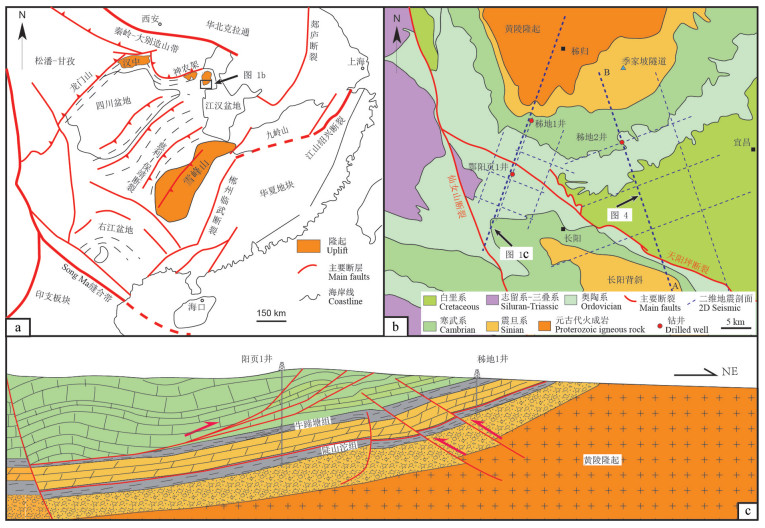
 下载:
下载:
